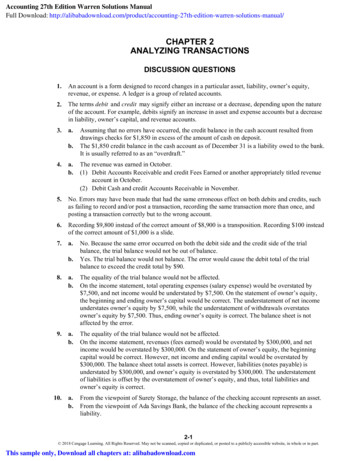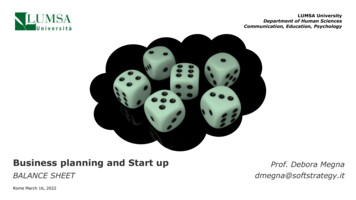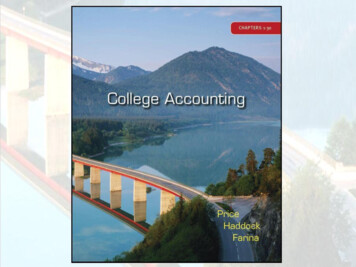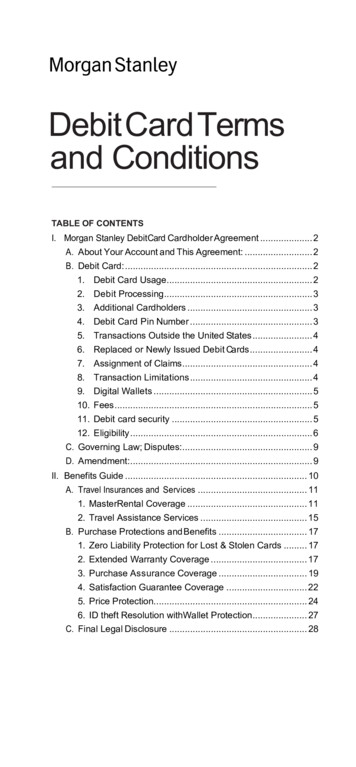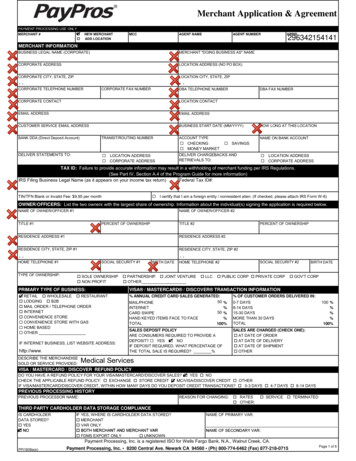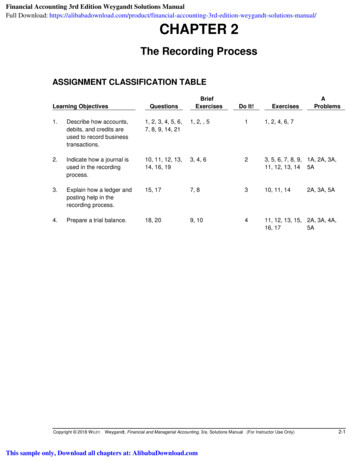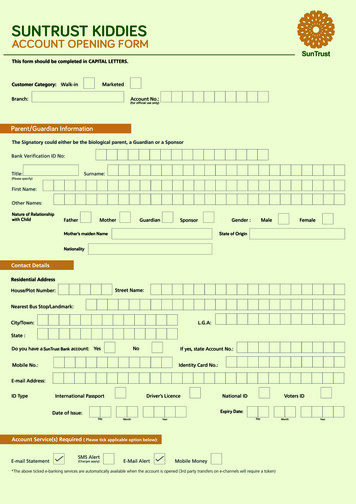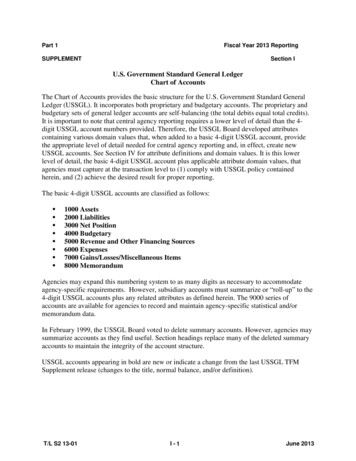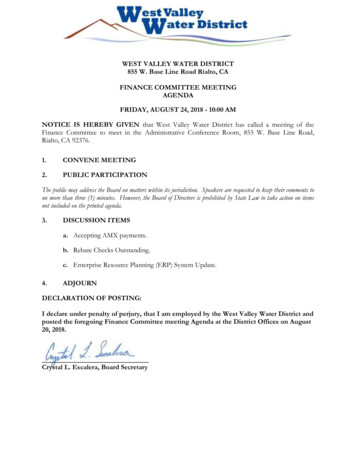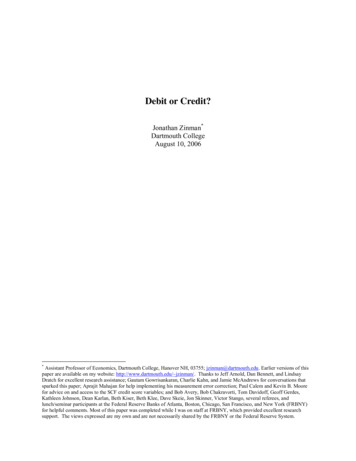
Transcription
Debit or Credit?Jonathan Zinman*Dartmouth CollegeAugust 10, 2006*Assistant Professor of Economics, Dartmouth College, Hanover NH, 03755; jzinman@dartmouth.edu. Earlier versions of thispaper are available on my website: http://www.dartmouth.edu/ jzinman/. Thanks to Jeff Arnold, Dan Bennett, and LindsayDratch for excellent research assistance; Gautam Gowrisankaran, Charlie Kahn, and Jamie McAndrews for conversations thatsparked this paper; Aprajit Mahajan for help implementing his measurement error correction; Paul Calem and Kevin B. Moorefor advice on and access to the SCF credit score variables; and Bob Avery, Bob Chakravorti, Tom Davidoff, Geoff Gerdes,Kathleen Johnson, Dean Karlan, Beth Kiser, Beth Klee, Dave Skeie, Jon Skinner, Victor Stango, several referees, andlunch/seminar participants at the Federal Reserve Banks of Atlanta, Boston, Chicago, San Francisco, and New York (FRBNY)for helpful comments. Most of this paper was completed while I was on staff at FRBNY, which provided excellent researchsupport. The views expressed are my own and are not necessarily shared by the FRBNY or the Federal Reserve System.
Debit or Credit?Jonathan Zinman*Dartmouth CollegeAugust 10, 2006ABSTRACTSeveral modeling, policy, and business questions hinge on how consumers respond tothe price of payments. For most consumers a critical pecuniary margin is the price of acredit card charge. A revolver who did not pay her most recent credit balance in fullmust start paying interest immediately; a convenience user floats. For many consumersthis price is the key economic difference between debit and credit. I find that revolversare at least 17% more likely to use debit after controlling for potential confounds. Debituse also increases with credit limit constraints and decreases with credit card possession.(99 words)Keywords: retail payments, household finance, two-sided markets, retail banking,high-frequency intertemporal consumer choice, payment cards*Assistant Professor of Economics, Dartmouth College, Hanover NH, 03755; jzinman@dartmouth.edu.1
I. IntroductionSeveral modeling, policy, and business questions hinge on how consumers respond to the price ofpayment instruments. The developing theory of two-sided markets suggests that the degree ofsubstitutability between debit and credit affects the welfare implications of how payment card networksare governed, operated, priced, and regulated.1,2 Retail payment price sensitivity also informs models ofhigh-frequency consumer choice, by speaking directly to the question of whether consumers areindifferent on the margin in the face of small stakes.3,4 And consumer price sensitivity can haveimplications for how payment card issuers compete and price their services. But there is little empiricalevidence on price sensitivity to inform these questions.5I estimate price sensitivity in retail payment choice by examining the most important pecuniarycost margin faced by most consumers: the price of a marginal credit card charge. A revolver who did notpay her most recent credit balance in full starts accruing interest immediately (at a median rate of 14.4%APR in 2001); a convenience user floats until her next payment due date (up to 60 days hence). The 70%of U.S. households who own a credit card face this implicit price; in contrast, only about 15% face cardtransaction fees, and only about 40% earn airlines miles or other rewards for charging. Debit and creditoffer similar attributes on other margins—acceptance, security, portability, and time costs— and hencethe price of a marginal credit card charge is the key economic difference between debit and credit formany households (see Section II for details).1See Chakravorti (2003) for a review of the theory literature on two-sided markets, and Rochet and Tirole (2006) for a specificexample (regarding the Honor-All-Cards rule) of how consumer price sensitivity can matter. These models generate welfareimplications and hence inform policy debates; see, e.g., recent antitrust actions taken by regulators and merchants against cardassociations in Australia, the U.K., and the U.S.2Rysman’s (2006) evidence on homing patterns and a correlation between usage and acceptance also informs two-sided marketmodels.3Section II-C estimates that typical payment card users face stakes ranging from 3 to 23 per month. Although the stakes ofany individual’s choice may be small, the high frequency and ubiquity of payment choices aggregate to large stakes (see fn 6).4See Miravete (2003) for a study of consumer calling plan choice that is similar in spirit and findings.5Notable exceptions are Borzekowski, Kiser and Ahmed (2006), which estimates the impact of fees on debit use using microsurvey data from the U.S.; and Humphrey, Kim, and Vale (2001) and Bolt, Humphrey, and Uittenbogaard (2006), which find thatretail payment choice is responsive to price in aggregate data from Norway and the Netherlands.2
I find that credit card revolvers are perhaps 17% (6 percentage points) more likely to use debitthan convenience users (see Section IV), conditional on a rich set of controls for transaction demand andother potential confounds (see Section III). Section V shows that this point estimate is likely aconservative lower bound on the true extent of consumer price sensitivity, and willingness to substitute,between debit and credit. I also show that debit use responds sharply to other implicit prices on creditcard payments: consumers facing credit limit constraints are discretely more likely to use debit, as arethose lacking a credit card altogether. Figures 1 and 2 summarize the key results graphically. In all, theresults suggest that at least 38% of debit use is driven by pecuniary cost minimization.The results have several implications for modeling. They suggest that models of paymentsnetworks as two-sided markets must take into account a substantial degree of price sensitivity andsubstitutability between debit and credit. They suggest that the right model of high-frequency, low-stakesintertemporal choice has the average consumer optimizing on the margin, rather than choosingindifference to conserve bandwidth. Additional evidence, presented in Section VI, casts a bit doubt onthe applicability of models with more sophisticated behavioral motives (e.g., mental accounting forspending control), although these tests are low-powered.The results also have implications for business and policy applications. The popularity andgrowth of debit is poorly understood. Debit is now used more often than credit at the point-of-sale, andincreased acceptance and improved security have been important proximate drivers of recent growth.6But which attribute(s) creates underlying consumer demand for debit? Anecdotal evidence suggests thatissuers have focused on the substitution of debit for cash and check for convenience reasons (Reosti2000), with academics sharing the view that debit’s growth has come largely at the expense of paperpayments (Chakravorti and Shah 2003; Borzekowski, Kiser and Ahmed 2006). My results suggest that6Debit transaction volume has been growing over 20% per year since 1996 (Borzekowski, Kiser and Ahmed 2006), andsurpassed credit in 2002 to become the most common form of Visa point-of-sale (“POS”) transaction in the United States (Visa2002). Overall, debit was used for over 15.5 billion POS transactions totaling 700 billion in the year 2002 (CPSS 2003). Thisrepresented about 35% of electronic payment transaction volume and 12% of POS noncash payments (Gerdes and Walton 2002).Industry observers predict continued strong growth for debit, while forecasting relatively weak growth in credit card chargevolume; see, e.g., McDonald and Wasserstrom (2003), Lyons (2004).3
debit is also a strong substitute for credit. A substantial part of debit’s popularity is due to its offering acheap plastic alternative to credit revolvers; consequently issuers should account for debit-creditinteractions (e.g., cross-price sensitivity) in formulating pricing, marketing, and network strategies.Policymakers should account for such interactions when evaluating the welfare and distributional impactsof proposed interventions in payment markets.II. Consumer Choice at the Point-of-Sale: A Simple ModelA. OverviewThis section details the consumer’s payment choice problem at the POS, and models it assumingthat traditional margins of transaction cost minimization drive the decision (see Section VI for someinformal consideration of models with spending control motives). I describe how debit and credit offeressentially identical advantages relative to alternative payments media and how they enjoy virtuallyidentical acceptance. Therefore it is straightforward to boil down the POS payment choice to onebetween debit and credit.7 The model then generates clear predictions on which consumers should bemore likely to use debit— those who revolve credit card balances, those who face binding credit cardcredit limits, and those who lack a credit card.B. Attributes of Payments MediaTraditionally, literature on media of exchange has focused on acceptance, security, portability,time costs, and pecuniary costs as the key elements of consumer payment choice (Jevons 1918). I beginby briefly comparing debit, credit, and alternative payments media (principally cash and check) alongeach of these first four dimensions, and then develop a simple model of consumer choice between debitand credit where pecuniary cost ends up being the key margin.7Throughout the paper I focus on “bank”-type credit cards (Visa, Mastercard, Discover, and Optima), which are also commonlyreferred to as “general purpose”. These stand in contrast to “store” or “proprietary” cards.4
Acceptance: Debit and credit enjoy similarly widespread acceptance as payments devices; Shyand Tarkka (2002) treat them as equivalent. Rough equivalence has come about due to the rise of“offline” (“signature”) debit, whereby an ATM card with a Visa or Mastercard mark can be used, as adebit card, anywhere the credit card brand is accepted.8 Consequently debit and credit are essentiallyequivalent along the acceptance margin when compared to cash or check.Security: Debit and credit now offer comparable fraud protection, and hence offer similar theftrisk compared to cash or check. Credit was generally better on this margin during my sample period,however. This pushes against the model’s testable predictions in ways that I explore in Section V.Time costs: From the consumer’s vantage point at the POS, debit and credit transactions aretypically processed exactly the same way, using either a POS terminal or signature-based transactions.These methods may be more or less time-consuming than cash or check, depending on the situation (Klee2006). Both debit and credit may be used to economize on (virtual) trips to the bank or ATM.9 Debit andcredit may pose different non-POS time costs (re: paying bills), these are considered in Sections V andVI.Portability: Debit and credit are plastic card-based media, offering identical advantages overbulkier cash and checkbooks.C. ModelThe similarities between debit and credit as payment devices suggests that an optimizingconsumer could optimally choose her POS payment method in two steps by:8There are a few exceptions; e.g., some merchants take only “online” (“PIN”) debit, and post-Walmart settlement (which is aftermy sample period) some merchants take credit but not signature debit. Hayashi, et al. (2003) describes the debit card industry’sinstitutions and operations.9About 17% of debit transactions involve “cash back” (Breitkopf 2003), and about 29% of debit users ever got cash back duringthe sample period under consideration in this paper (December 1996 Survey of Consumer Attitudes and Behavior). Cash back isonly available in the 25% or so of merchant locations where there are the POS terminals required for “online” (PIN-based) debit(Breitkopf 2003)5
1. Deciding whether to use “paper” (cash, check) or “plastic” (debit, credit), based on the four marginsdiscussed above.2. Minimizing pecuniary costs, conditional on the choice in step 1.10Then in the case where the consumer is using plastic, she faces the following problem:(1) Min [Cd(p), Cc(H, f, r(R, rpurch, B, L))]Cd and Cc and represent the marginal (implicit) pecuniary cost of using debit and credit,respectively. The direct cost of Cd debit depends on p, the amount of the transaction fee that is sometimeslevied. During the sample period under consideration in this paper only about 15% of debit cardholdersfaced transaction fees (Marlin 2003), and the modal nonzero fee was 25 cents (Dove 2001).11 Most feesare charged on online debit transactions only; charges per offline or credit card transaction have been veryrare in the United States. For the purposes of discussion I assume that debit transactions clear with aneffective interest rate of zero, ignoring settlement lags (which can provide a day or two of float) andcostly checking account overdrafts (Fusaro 2005).The cost Cc of using credit depends first on H, whether the household has a credit card. Assume forsimplicity that households lacking a credit card (H 0) do so only for supply reasons. (This seemsplausible in a standard consumer choice framework, where holding a credit card is essentially costless,given the prevalence of no-fee cards and strong fraud protection.) Then Cc is infinite for these householdsand debit is of course relatively attractive.10See, e.g., Whitesell (1989), Whitesell (1992), and Santomero and Seater (1996) for more comprehensive models of consumerpayment choice.11Borzekowski, Kiser, and Ahmed (2006) find that similar prevalence of fees in 2004, with a median fee of 75 cents.6
Cc also depends on f, the “rewards” benefits (e.g., airlines miles, rebates) available per unit charged.These incentives typically have been more prevalent and generous for credit than debit, and can be valuedat approximately one cent per dollar charged for the 50-60% or so of cardholders earning rewards.12Cc depends finally on r, the effective interest rate at which the consumer must borrow (or float) tocharge a purchase at the point of sale. r in turn is determined by R, a discrete variable capturing whetherthe consumer revolved a balance at her last credit card payment due date (assume for the moment that theconsumer holds only one credit card; I consider the complication of multiple cards in Section III). Incases where R 1, i.e., where the consumer did not pay her balance in full, then she must borrow-tocharge— each dollar charged on the margin begins accruing interest immediately at the consumer’s“purchases” rate, rpurch.13 Thus when R 1 debit use is relatively attractive.14 In contrast, when R 0 theconsumer gets to float for 25 days on average (Garcia-Swartz, Hahn and Layne-Farrar 2004), and retainsthe option to borrow, so r 0.15Overall the stakes of making the “correct” payment choice at the POS, conditional on R, will besmall in most cases. A typical revolver who borrows-to-charge pays about 12 per month to do so.16 Atypical debit user who forgoes credit card float (and miles) loses perhaps 3 ( 23) per month.17 In thepresence of uncertain cash flows, the cost of using debit incorrectly could be significantly higher due to12The December 1996 Survey of Consumers found that 56% of credit card holders had a card with rewardsThe Federal Reserve Board of Governors’ biannual publication “Shop: The Card You Pick Can Save You Money” states:“Under nearly all credit card plans, the grace period applies only if you pay your balance in full each month. It does not apply ifyou carry a balance forward.” See, e.g., the January 1998 or August 2001 versions. Nationally representative surveys have foundevidence suggesting that most credit card holders are cognizant of the interest rates charged on their plans; e.g., Durkin (2000)reports that at least 85% are aware of their APRs, and Durkin (2002) reports that 54% of holders consider rate information the“most important” disclosure, with 78% of holders responding that the APR is a “very important” credit term (compared to only25% for rewards).14In principle the intensive margin of the cost of revolving, rpurch , should provide an independent source of variation in incentivesfor debit use along with the extensive margin R. But in practice this is unlikely to be the case, due to data limitations, the largeaverage wedge (over 1,500 basis points) between rpurch and the cost of floating, and relatively limited steady-state dispersion inrpurch .15For analytical simplicity, I incorporate the opportunity cost of transaction balances, incurred by using debit, into the effectiveinterest rates. This simply increases the reward to floating, and reduces the effective rpurch by the amount of the opportunity cost.16A revolver with nonzero but nonincreasing demand for credit card debt and no rewards for credit card charges, who used hercredit card to borrow-to-charge rather than using debit and made credit card payments only once per month, would spend about 12 more per month to charge an amount equal to one-half of one month’s median income ( 2,000) at the median rate revolversface (14.5% APR). Assuming electronic POS payments do (or could) equal to one-half of income is probably too high, given thepreponderance of expenditure that can not be paid by credit or POS debit.17A nonrevolving consumer who held a credit card but used debit for 2,000 worth of purchases would forgo about 3.33 permonth in float given a riskless real return on assets of 2%, and 20 per month worth of rewards where applicable (assuming theindustry-standard reward valuation of one cent per dollar charged).137
nonlinear overdraft penalties. If overdraft risk is present but unmeasured (as in this model, and itsempirical implementation below) this may induce some revolvers with nonincreasing demand for credit toborrow-to-charge instead of using debit.r also depends discretely on whether B, the amount outstanding on the credit line L, exceeds L.When B L typically three adverse things happen to the consumer: i) the rate on the outstanding balanceincreases substantially, i.e., rover rpurch; ii) an overlimit fee ranging from 20- 30 is incurred, and iii) hercredit rating worsens.18 r may also vary smoothly with B and L, depending on the option value ofborrowing (more on this in Section IV). Debit thus becomes relatively, and potentially discretely,attractive as B approaches L.In summary, consumers face a complex optimization problem over relatively small stakes whenchoosing a payment method at the POS. They are confronted with several payment options, several costmargins (only some of them explicit), intertemporal tradeoffs, and uncertain cash flows. The stakes arenontrivial but probably less than 20 per month for most consumers. A standard model predicts that debitshould be relatively attractive to households lacking a credit card, revolving a credit card balance, and/orfacing a binding credit card limit constraint.D. Not Modeled, Not Needed: Transaction Demand and Portfolio ChoiceThe model thus far has presumed that transaction demand and portfolio choice are exogenous tothe decision about whether to use debit. In principle, these assumptions are innocuous, since the model’spredictions hold for any marginal transaction, given the values of the cost variables.19 In practicehousehold portfolio choices with respect to the simultaneous holding of liquid assets and credit card debthave raised eyebrows and motivated behavioral explanations; see, e.g., Gross and Souleles (2002),Bertaut and Haliassos (2002), and Haliassos and Reiter (2005). But recent work shows that these18Furletti (2003) is an excellent source of information on credit card pricing and related developments.Debit and credit may be chosen jointly as well. Forward-looking consumers may take into account the availability of debit indeciding whether to borrow on credit cards, since the availability of debit makes steady-state revolving slightly cheaper byproviding the benefits of electronic POS payments without borrowing-to-charge. This interaction reinforces the model’sprediction that revolvers should be more likely to use debit.198
portfolio positions can be reconciled with traditional rationality subject to payment and credit marketfrictions that give liquid assets implicit value (Telyukova 2006; Zinman 2006).A more important practical consideration is that unobserved transaction demand creates anidentification issue. I deal with this in the next section.III. Data and IdentificationI now detail the empirical implementation and identification of the model developed in the previoussection. The model’s predictions suggest estimating the following types of equations:(2) Yi f(Hi, Ri , Fi , Xi)(3) Yi f(Ri , Xi Hi 1)where i indexes consumers, Y is a measure of debit use, H is cardholding, R is revolving, F captureswhether the household faces a binding credit card limit constraint, and X includes several variables thatcan be used to help identify the model by capturing other payments costs, payments and credit demand,and tastes.The model predicts that Y/ R (“βR”) and Y/ F (“βF”) will be positive, and that Y/ H (“βH”) will be negative. In each case the null hypotheses is that β 0. Equation (3) simplifies (2)in order to focus on the model’s starkest prediction, that βR 0, by ignoring F and limiting the sample tocardholders (H 1).I focus for now on the data and identifying assumptions required to implement equation (3) as atest of whether and how strongly consumers respond to the relative price of payment instruments. Ipostpone detailed consideration of how the results speak to the relative explanatory power of differentmodels of high-frequency consumer choice (neoclassical vs. rational indifference vs. mental accounting)until Section VI.I use data from the 2001 Survey of Consumer Finances (SCF), a nationally representative crosssection of 4,442 U.S. households. The SCF contains some information on debit use and detailed data on9
credit card use, financial status, and household characteristics.20 I set Y 1 if the household reports usinga debit card and zero otherwise,21 and R 1 if the household did not pay its most recent balance in full onany bank credit card. The SCF is the best available nationally representative source with the necessarydata on both debit and credit usage. Nevertheless data limitations create three identification issues.The first identification issue stems from the fact that the SCF does not report balances forindividual credit cards, but rather total balances outstanding over all of the household’s bank credit cards.This creates a downward bias on βR if some households use separate credit cards for borrowing andtransacting, and motivates close consideration of samples that are restricted to the 25% of householdswith only a single credit card.The second identification issue stems from omitted variables on debit and credit paymentattributes: debit transaction fees, cash back usage, rewards incentives, and merchant acceptance. Each ofthese unobservables biases βR towards zero by producing revolvers who do not use debit due to someunobserved cost (e.g., to rewards incentives or overdraft risk), or nonrevolvers who do use debit due tosome unobserved cost (e.g., time cost savings from cash back transactions or avoiding the need for acredit card bill payment).Control variables for demographics, attitudes, and household financialcondition will mitigate the downward bias on βR if they are correlated with debit use, revolving, and theunobserved attributes/costs.A third identification issue is the possibility that βR 0 simply picks up indifference. This wouldoccur if revolvers are relatively “big spenders” who choose their payment device haphazardly, perhapsbecause the computational costs of finding the right solution outweigh the benefits. In this case revolversmight be mechanically more likely to use debit because they transact more. The binary nature of mymeasure of debit use mitigates this concern. I also control for underlying transaction demand with data onwealth, income, income shocks, spending relative to income over the past year, the interest rate on20For more information on the SCF see, e.g., Aizcorbe, et al. (2003)See Appendix 1 for the debit use survey question. The SCF does not have any data on usage intensity. The SCF yieldsproportions of debit users comparable to other surveys; e.g., the Standard Register’s National Consumer Survey of Plastic Card2110
revolving balances, the number of credit cards, credit card charges, and the use of other electronicpayments. The latter variables also help (over-)control for any “taste for plastic” that may be correlatedwith revolving behavior but not necessarily indicative of cost minimization as defined by the model.Overall then, estimating (3) using probit will, under the usual distributional assumptions about theerror term, identify whether debit use responds to the price of a marginal credit card charge. Theestimates are subject to various downward biases in favor of null effects. I estimate some bounds onthese biases in Section V.I round out the empirical specifications by pooling SCF cross-sections in some cases. The SCFhas been conducted every three years since 1989 and asked questions on debit use since 1992 (Table 1shows the rapid growth of debit use among SCF households from 1992 to 2001). As the survey lacks anypanel component in the years under consideration, the pooled specifications simply add year effects T toproduce, e.g.: 22(4) Yi f(Ri , Xi, Tt Hi 1)IV. Core ResultsThis section presents results obtained from estimating versions of equations (2)-(4). The findingsare consistent with each of the model’s three predictions: revolving and facing binding credit constraintsare found to be positively correlated with debit use, while holding a credit card is negatively correlatedwith debit use.Usage, a random phone survey of 1,202 households, found that 37% were debit users in March 1999. The 1998 SCF (collectedJanuary-August) found that 34% of households used debit.22One issue not captured in the notation is that the SCF produces 5 implicate observations per household in order to maximizeprecision in the presence of substantial imputation of certain financial variables; see, e.g., Kennickell (1998) or Little (1992).Although I use the full dataset of 5 observations per household (and correct standard errors accordingly, using the routineprovided by the 2001 SCF codebook at odebk2001.txt), reported samplesizes count the number of households.11
I first estimate βR, the correlation between revolving credit balances and debit use, by runningprobit versions of equations (3) and (4) on several samples from the SCF.23 The marginal effects,presented in Table 2, suggest that revolvers are significantly more likely to use debit, to the tune ofperhaps 6 percentage points (which is 17% of the baseline probability). As noted above, the “base”specification contains several covariates in the X vector that are designed to help identify βR. Thesevariables include controls for debit card supply (census region,24 housing type, and ATM cardholdingstatus); and for life-cycle and transient proxies for transaction demand and secular tastes that might affectpayment choice (income last year, last year’s income relative to average, number of household members,homeownership status, marital status, attitudes toward borrowing for luxury items, occupation, age,gender, educational attainment, military experience, race, and 1-digit industry).25 Table 3 presents somerelated summary statistics, and detailed variable definitions are available in Appendix 2. Appendix Table1, column 1 presents results obtained for the control variables when estimating two of the specificationsin Table 2. The (pseudo) R-squareds are high by cross-sectional standards (e.g., 0.23 when using probiton the pooled sample).Comparing Column 1 to Columns 2-5 indicates that the correlation between revolving and debituse is robust to different controls for “big spenders” and a “taste for plastic”. Column 2 takes the basespecification and adds a quadratic in net worth and categories for spending relative to income in the pastyear. Column 3 then adds dummy variables for whether the household uses other electronic paymentmedia or computer banking. Column 4 adds the number of bank credit cards, last month’s bank creditcard charges, and the interest rate paid on revolving balances. Column 5 add the interaction between thenumber of cards and revolving status (since SCF revolvers may in fact hold multiple cards for the expresspurpose of maintaining one for convenience use). In all the results in Columns 1-5 alleviate concerns,23Throughout the paper I report probit marginal effects with SCF sample weights; using linear probability or logit producesvirtually identical results. The results are also robust to using unweighted estimation on samples that exclude wealthy householdsa la Hayashi and Klee (2003).24Census region is not available in the 2001 SCF public release; results estimated on the 1995 and 1998 do not change if regionis omitted.25Results do not change if one-digit occupation code is used instead of, or in addition to, industry.12
discussed in Section III, that the observed correlation between revolving and debit use is driven byunderlying transaction demand coupled with indifference, or by a preference over payment types that isunrelated to pecuniary cost minimization.Table 2 also exhibits the effects of limiting the sample based on cardholding (Column 6) andcharging behavior (Column 7). These cuts are motivated by the measurement issues discussed in SectionIII, but in fact leave the results unchanged in most cases. The results are also robust to other alternativemeasures of revolv
2006). Both debit and credit may be used to economize on (virtual) trips to the bank or ATM.9 Debit and credit may pose different non-POS time costs (re: paying bills), these are considered in Sections V and VI. Portability: Debit and credit are plastic card-based media, offering identical advantages over bulkier cash and checkbooks. C. Model
